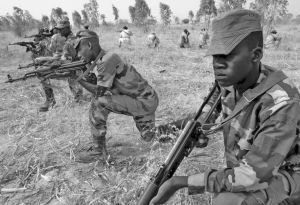The number of Canadian miners poking the arid terrain of Niger in the search for uranium is increasing, and the relative durability of the uranium price in a down market isn’t the only thing fuelling their inquisitiveness.
Possessing one of the world’s best uranium resources, Niger has long been all but closed off to foreign investors — unless they were French.
The one-time colonizers discovered uranium in the country while looking for copper in the late 1950s and secured deals with the government that, until recently, guaranteed the European power a virtual monopoly on Niger’s uranium assets.
Things began to loosen somewhat in 2005, when the government drafted a mining code much in line with other West African countries. Some junior miners like North Atlantic Resources (NAC-T, NOATF-O), which was doing work in neighbouring Mali, took notice and staked some claims.
But it wasn’t until the summer of 2007 that real change came. In July of that year, the government took the extreme step of expelling from the country French nuclear giant Areva’s (ARVCF-O) director of operations in Niger.
That move came amidst terse negotiations that saw the government trying to get a better share of uranium’s selling price — it had agreed in the past to settle for a severe discount — and appease Touareg rebels in the north who were violently complaining about the lack of benefits they have seen from Areva’s uranium operations.
A new deal with Areva was struck later that year, one that saw the government take a larger share of the spot uranium price and, importantly for foreign investors, eliminated Areva’s preferential treatment with regards to exploration licences.
Areva operates two mines in the country, Cominak and Somair, and the renegotiation with government cleared the way for the development of its third and most ambitious mine in the country, Imouraren.
Areva describes the Imouraren deposit as the largest known uranium deposit in Africa, and the world’s second largest, after Australia’s Olympic Dam. The company plans to begin mining in 2010 with annual production of 5,000 tonnes U308 per year.
The US$1.5-billion project would propel Niger to the second-largest producer of uranium in the world, from fourth place. Only Canada would rank higher.
And while such a mega-project is a ringing endorsement for the uranium industry in the country, it doesn’t come without caveats.
Niger has recently been in the news with the kidnapping of two Canadian diplomats late last year, Robert Fowler and his assistant, Louis Guay. Areva has had four of its employees kidnapped, and in contrast to the Canadian case, the perpetrators and the motives of the Areva kidnappings are known — the disgruntled Touareg tribe claimed responsibility.
That atmosphere has made miners wary of exploring the grounds they are otherwise eager to get at.
But that too is changing, says North Atlantic’s president and chief executive, Scott Waldie.
Waldie admits the unrest has slowed exploration at his company’s Abelajouad uranium permit, which sits just 5 km west of Imouraren.
But despite the lack of a peace agreement between the government and the Touareg, Waldie says tensions have eased since his field workers left the area for their own safety more than a year ago. He plans to have his exploration team back on the ground in three months.
“It is not the rebels’ stated business to stop us,” Waldie explains. “GoviEx is going ahead; Areva is going ahead, so it’s very possible to work there.”
GoviEx, or Govi High Power Exploration holds 2,300 sq. km of exploration property in the region around Arlit, in northern Niger, roughly 200 km from the Algerian border. It also has another 2,400 sq. km near Agadez, 175 km south of Arlit.
A quick look at the management of GoviEx reveals a name not unfamiliar with making the next big find — Friedland. In the case of GoviEx, however, it is not the much-heralded head of Ivanhoe Mines(IVN-T, IVN-N), Robert Friedland, but his son, Govind Friedland who is president and chief executive officer.
And while Govind Friedland may well be on the way to a big find, it is still early days for miners other than Areva. Canada’s uranium giant Cameco (CCO-T, CCJ-N) is taking an interest in Niger by acquiring 11% of GoviEx for $28 million. If things go well, it could increase its interest to a 48% stake over the next four years for a cost of between $145 million and $212 million.
Waldie says the presence of big players like Cameco and Areva can only help to improve the investment climate for the smaller players who continue to file into what is still a vastly underexplored region.
And the investment dollars they bring are most welcome in Niger — a country widely held to be one of the poorest in the world, with a GDP of just US$5.3 billion.
“There’s tremendous potential there,” Waldie says. “We kept a crew there and we kept our offices going even through the rougher times for a reason.”
Other Canadian-based companies exploring for uranium in Niger include: Aguila American Resources (AGL-V, AGLAF-O), Bayswater Uranium (BAY-V, BYSWF-O), NWT Uranium (NWT-V, NWURF-O), Rockgate Capital (RGT-V), Southampton Ventures (SV-V), and Semafo (SMF-T, SEMFF-O).


Be the first to comment on "Niger: An Old Uranium Frontier Made New Again"